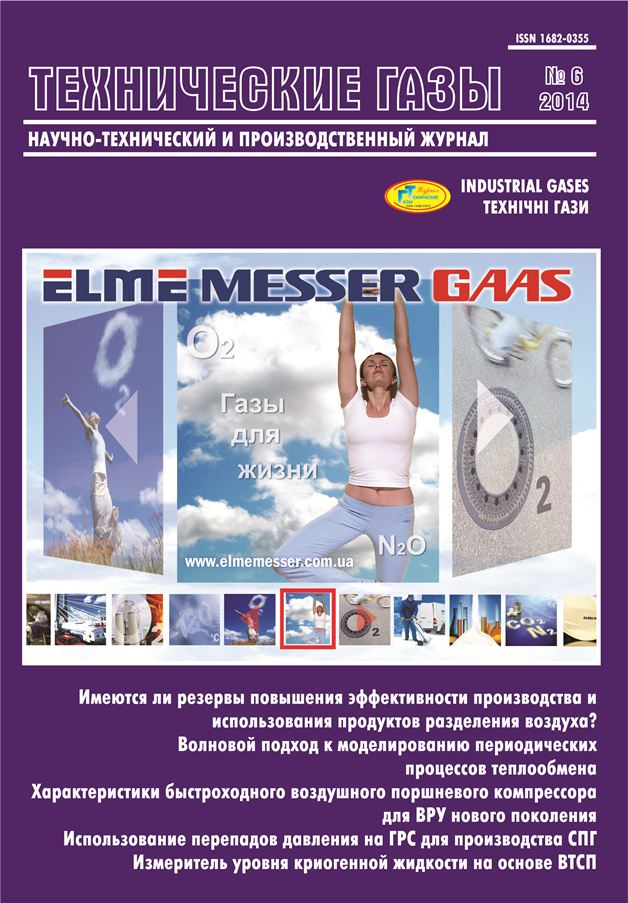THE WAVE APPROACH TO MODELING OF THE PERIODIC PROCESSES OF HEAT EXCHANGE
DOI:
https://doi.org/10.18198/j.ind.gases.2014.0752Keywords:
Periodic processes of heat exchange, Regenerative heat exchanger, Gas cryogenic refrigerator, Reverse Stirling cycleAbstract
The wave approach to the description of periodic processes of adsorption and desorption allows from unified position to consider various adsorption technologies of the separation of gas mixtures. Due to similarity of the processes of heat and mass exchange all the results obtained for periodic adsorption processes can be successfully transferred to the similar processes of heat exchange. The description of the wave approach to the construction of a mathematical model of the regenerative heat exchanger has been presented. The analysis of the adequacy of the mathematical model to the real processes of the heat exchange by the example of the regenerative heat exchanger of the gas cryogenic refrigerator. The maximal efficiency of the regenerative heat exchanger was found to be 0.81 which is very close to the actual value at which the refrigerating capacity of the refrigerator at nitrogen temperature level is 700 watts.
References
Kravchenko M.B. (2011). Wave adsorption. Analytical description and analysis of processes// Tekhnicheskie Gazy. [Industrial Gases]. — № 5. — P. 49-59. (Rus.).
Kravchenko M.B. (2012). Wave adsorption. Influence grain size of the adsorbent on pressure swing adsorption// Kholodilnaya tekhnika i tekhnologiya. [Refrigeration Engineering and Technology].— № 3. — P. 63-74. (Rus.).
Hauzen H. (1981). Heat transfer countercurrent, co-current and cross-current. — М.: Energoatomizdat, — 384 p. (Rus.).
Kravchenko M.B. (2014). Wave adsorption. — Saarbrucken: Lap Lambert Academic Publishing, — 168 p. (Rus.).
Kravchenko M.B. (2007). A simple way to improve the efficiency of direct ribs// Kholodilnaya tekhnika i tekhnologiya. [Refrigeration Engineering and Technology]. — № 5. — P. 59-65. (Rus.).
Chowdhury K., Sarangi S. (1983). Effect of finite thermal conductivity of the separating wall on the performance of counterflow heat exchangers// Cryogenics. — V. 23. — № 4. — P. 212-216.
Chowdhury K., Sarangi S. (1988). Performance of cryogenic heat exchangers with heat leak from the surroundings// Advances in Cryogenic Engineering. — V. 33. — P. 273-280.
Pradeep Narayanan S., Venkatarathnam G. (1999). Performance of a counterflow heat exchanger with heat loss through the wall at the cold end// Cryogenics. — V. 39. — P. 43-52.
Kravchenko M.B. (2010). Analytical research of counterflow heat exchangers// Tekhnicheskie Gazy. [Industrial Gases]. — № 5. — P. 24-30. (Rus.).
Kravchenko M.B. (2010). Optimization the opposite heat exchangers// Tekhnicheskie Gazy. [Industrial Gases].— № 4. — P. 37-43. (Rus.).
Mikusinskiy Yan. (1956). Operator calculus. — М.: Publishing House of Foreign Literature. — 366 p. (Rus.).
Kartashov E.M. (1985). Analytical methods in the theory of thermal conductivity of solids. — М.: Vyisshaya shkola. — 480 p. (Rus.).
Aerov M.E. Todes O.M. (1968). The hydraulic and thermal basics of vehicles with fixed and fluidized granular layer. — L.: Khimiya. — 512 p. (Rus.).
Downloads
Issue
Section
License
LICENSE AGREEMENT
After receiving an article for publication as required revision scientometric databases each author directs the license agreement on the assignment and transfer of the management of copyright. Signatures of the author (s) it is desirable to seal the personnel department of the institution where the author works (authors), or the seal of the Faculty.
Revision refers to the authors one layout for proofreading. Permissible only those fixes that result in compliance with the layout of the original text of the article. Significant changes are not permitted. Layout should be sent to the editorial office within days of receipt.

